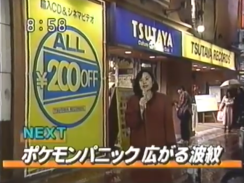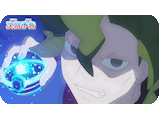
038



Main
Old Updates Archive
Links
 |
Lists |
List of Pokémon
Pokémon World Atlas
List of Techniques
List
of Items
List of TV Episodes
 |
Guides |
Episode
Comparisons
Movies
& Specials Guide
CD Guide
DVD Guide
Voice
Actors Guide
Lyrics Archive
Manga Guide
Video Games
 |
Miscellaneous |
Humor
Pokémon Bashing
Features
Rants
Dogasu's
Backpack
| Episode Comparisons | Kanto Region

Japanese Episode 038: "Cyber Soldier Porygon"
Pokémon Dare Da? Porygon
Japanese Air Date: December 16th, 1997
American Air Date: Never aired
Important Characters: Dr. Akihabara (N/A)
Important Places: Matcha City (N/A)
The Pokémon Center in Matcha City is in a big panic! Apparently, people who had been using the Pokémon transfer system to send Pokémon to their friends are finding that their rare and valuable Pokémon are being swapped out for common ones! Satoshi and his friends head to the laboratory of the system's inventor, Dr. Akihabara, in order to see if it can be fixed. When they arrive, they are greeted by a holographic rendering of the professor that informs them that the Rocket-Dan are behind the system's malfunction. The hologram leads Satoshi and his friends into a cylindrical chamber that can, unknown to them, send them into the computer world! Once inside, the trio, along with Dr. Akihabara's Porygon, finds the Rocket-Dan and sees that they've set up road blocks to stop the flow of Monster Balls. As a battle between Dr. Akihabara's Porygon and a Porygon the Rocket-Dan had stolen begins, Satoshi and his friends take the opportunity to undo the Rocket trio's work. Elsewhere, Joy calls a computer technician over to install an anti-virus program into the transfer system's software. Once Dr. Akihabara learns about the program, he warns our heroes that it will see them as a threat and try to destroy them! The humans inside the computer world hitch a ride on the back of the professor's Porygon and high tail it to a portal that will send them out of the computer. With only seconds to spare, our heroes escape into the real world. Now that the computer program has been fixed, Satoshi and his friends head off on their next adventure.
Thoughts
"Cyber Soldier Porygon" is probably one of my favorite episodes from the first series. The episode has a one-of-a-kind location, shows off an aspect of the franchise that's often overlooked, and has a really eccentric character of the day. I mean, what's not to like about a wacky old guy who greets visitors to his mansion-looking lab with a 3D hologram? Or about a Joy who actually takes matters into her own hands?
This episode also stands out to me not only because of what it did, but also because it was my very first exposure to this franchise. By the time 1997 came around, I was hungry for anything out there that had that "anime" label. Yes, I was one of those teenagers. So when I heard about how this Japanese cartoon sickened "hundreds of children," my curiosity was piqued. "What was this show about?" and "Why haven't I heard of it?," I asked myself. I eventually found out that "the show that caused all those seizures" was coming to America so I planted myself in front of the TV to see this show for myself. I've been here ever since.
Pocket ni Fantasy replaces Nyarth no Uta as the ending theme as of this episode in Japan.
"Pokémon Shock" section on Dogasu's Backpack
I have a lot more information about the incident over in the "The Pokémon Shock Incident" section of this site's Features section. This page you're on right now is more of a high level overview; if you would like to learn more in-depth information about the incident as a whole then I highly recommend checking out the feature.
Portions of the content below will eventually be migrated over to that Feature.
Why the episode was banned
I know I don't have to tell you this, but just in case: "Cyber Soldier Porygon" is the episode of Pocket Monsters that caused seizure-like symptoms in about 700 Japanese kids.
During a scene that aired at around 6:51pm, Satoshi's Pikachu jumps up and lets off a 10,000 Volt attack to take care of a missile headed its way. The resulting explosion filled the screen with red and blue lights for about four and a half seconds, with post-episode reports revealing that these lights flickered over 100 times during this very short period of time.
Altogether it was estimated that about 3.45 million children between the ages of four and twelve were watching Pocket Monsters that night. Video research at the time estimated the TV ratings during this episode were 16.5% for the Kanto region (as in the real-world Kanto located in Japan, not the Pokémon location) and 10.4% in the Kansai region.
After the scene aired, children all over Japan reported dizziness, headaches, nasuea, lost memory, and nosebleeds. The number of children affected varies from news outlet to news outlet but TV-Tokyo estimates that about 135 of the 750 total people affected had to stay in the hospital overnight.
Benjamin Radford of the Center for Inquiry wrote this fantastic article about the incident that goes into much more detail about each of the victims and a breakdown as to what exactly caused all those people to feel ill.
The incident was given numerous names by the Japanese media, including "Pokémon Shock," "Pokémon Panic," "The Pokémon Incident," "Porygon Shock," and "Pokémon Flash."
Effects on Pokémon - Pokémon's vanishing act and the four month hiatus
After reports that children had gotten sick began to circulate, a tremendous fallout began.
TV-Tokyo, the network that airs Pocket Monsters, apologized the following day and abruptly pulled the show from its schedule. While they launched an internal investigation to find out why this happened, the network put a show called Gakkyuu Ou Yamazaki (学級王ヤマザキ) in Pocket Monsters' old time slot.
During the episode of Revolutionary Girl Utena that aired on TV-Tokyo the following night, text appeared on-screen urging viewers not to re-watch any VHS recordings they may have made of the Pocket Monsters episode the night before (きのう放送分の「ポケットモンスター」を (記録した) ビデオでご覧にならないようにお願いします). Episodes of Pocket Monsters that had already been released on home video at the time were pulled from video rental stores across the country.
The Japanese Wikipedia page for the Pokémon Shock incident states that radio show that voice actress Inuyama Inuko had at the time, "Inuko Inuyama 's Pokémon Hour" (犬山犬子のポケモンアワー), addressed the incident shortly after the episode aired. According to the article, a listener called in to Ms. Inuyama and asked two questions; are they ever going to air an edited version of the Porygon episode, and are they ever going to get around to airing "Rougela's Christmas," the episode that had been scheduled to air the following week. In regards to the Porygon episode, Inuko Inuyama said that they would like them to treat the episode as an "illusion" and as "an episode that never existed" (「あの回(第38話)は幻にしてほし い」「なかった話とし てほしい) but that they definitely do want to air the Rougela episode (あと次回分で予告された『ルージュラのクリスマス』の放送 は必ずやるので安心してほしい」). "Rougela's Christmas" did eventually air as an "extra episode" the following October.
 The
episode has never been re-aired, and, as far as all the official
companies are concerned, the episode doesn't exist. The episode's title is missing
from all official listings
of the series. In fact, the desire to expunge this episode from
existence
even went as far as to omit it from the Pocket Monsters
Film Comic, the books that take screenshots from the episodes and
arranges them into a comic book retelling of the episode.
The
episode has never been re-aired, and, as far as all the official
companies are concerned, the episode doesn't exist. The episode's title is missing
from all official listings
of the series. In fact, the desire to expunge this episode from
existence
even went as far as to omit it from the Pocket Monsters
Film Comic, the books that take screenshots from the episodes and
arranges them into a comic book retelling of the episode.
A number of Pokémon-themed specials scheduled for the end of 1997 and the beginning of 1998 were also canceled as a part of the network's Pokémon blackout. TV-Tokyo's variety show "News! The Decisive Source "A Pokémon Course for Fathers"" (情報! ソースが決め手 "お父さんのためのポ ケモン講座 ") was swapped out with a highlights-of-the-year special. The December 30th episode of the network's video game variety show "64 Mario Stadium" (64マリオスタジアム) was postponed until January 18th because it featured a "Pokémon Corner" segment. Reruns of Episodes 025 and 026 of the Moomin TV series aired on the originally scheduled date instead. The "New Year's Eve Pocket Monsters Encore" (大晦日だよポケットモンスターア ンコール) special was canceled and replaced with a rerun of Mojackou (モジャ公). A mini-special named "Pokémon Quiz" (ポケモンクイズ) was replaced with "Special Program - Gift Recommendations for the New Year" (お 年玉付き新春オススメとくばん).
Meanwhile, a different TV network NHK apologized for not investigating an incident that occurred in March of that same year when an episode of YAT Relieved! Space Vacations (YAT 安心!宇宙旅行) caused similar symptoms in four children. The network didn't launch an investigation at the time because of the small number of victims. Many feel that if this incident had been investigated properly then the "Pokémon Shock" could have been avoided.
After months of fans expressing their desire for the show to return to the air, TV-Tokyo made an announcement on March 30th that the show would be coming back. When it returned it did so with two back-to-back episodes on April 16th, 1998, and was moved from 6:30pm Tuesdays to 7:00pm Thursdays. Overall, the show's hiatus lasted four months.
Effects on Pokémon - Bye Bye Porygon
In addition to all this, Porygon itself has become sort of the black sheep of the Pokémon universe. Ever since its debut episode, the Pokémon and its evolutions (Porygon 2 and Porygon Z) have never gotten a starring role in an episode. They're still in the games and the comics and all that, but outside of a few cameos in some of the movies' "World of Pokémon" segments, the Porygon line simply doesn't exist in the TV series.
Many people are understandably upset by this. After all, it was Pikachu who launched the seizure-inducing attack, not Porygon. Why isn't that electric rat banned instead?
The thing is, Porygon will always be tied to this episode because of our tendency to label episodes based on the Pokémon who stars in them. If I say that I want to talk about the Garura episode, for example, you know exactly what episode I'm talking about. If I say "the Ponyta episode," you know that I mean "The Big Blazing Pokémon Race!" Episodes tend to get labeled depending on the star, and in this case, Porygon was the main attraction. Not Pikachu.
It doesn't seem like this ban on Porygon is going to be lifted anytime soon.
Effects on Pokémon - The editing of existing episodes and the creation of future episodes
After the incident, OLM and TV-Tokyo went back to all the episodes they had made up to that point and re-edited them to fit with the new guidelines that had been put in place by the National Association of Broadcasters in Japan. Scenes with a lot of flashing or quick cuts were darkened and slowed down even though those very same scenes had already aired (some of them multiple times) without incident.
Another change made was to the show's opening theme, Mezase Pokémon Master. In the pre-Pokémon Shock days, each instance of the word "naka" at the beginning of the song were accompanied by a full-screen image of a random Pokémon. For all broadcasts after the incident, those full-screen images were shrunk down to a fourth of their size and placed four to a screen. This way, only a small portion of the screen would flash when the image changed rather than the entire thing.
Episodes that were still in production when the Pokémon Shock incident occurred had to be edited similarly. Before the first movie was released in theaters, a message in the film's trailer assured parents that the movie didn't contain any flashing scenes.
Episodes made after the incident were created with these new guidelines in place and therefore did not require any additional editing.
Reruns of older cartoons were edited in ways similar to how older Pocket Monsters episodes were edited. Reruns of shows like Revolutionary Girl Utena, Crayon Shin-chan, Rurouni Kenshin, Dragon Ball, Doraemon, and Flame of Recca have all had certain episodes re-edited to slow down and dim scenes that no longer conform to modern day guidelines.
Foreign programming must adhere to the guidelines as well. The 2003 TMNT series had frames removed and / or slowed down in order to be able to air on Japanese TV. Light saber battles in Star Wars movies get slowed down and dimmed whenever they air on TV. Footage of press conferences get slowed down due to the constant flashing of the reporters' cameras.
Like their domestic counterparts, these scenes are usually shown unedited in the home video release.
But why was all this necessary?
All of these cancellations and apologies and retroactive edits may seem ridiculous from a Western point of view, but the handling of the incident is standard protocol for these types of things in Japan. Just look around the Japanese media for a bit. L'Arc en Ciel drummer Sakura was arrested for heroin possession, so the Rurouni Kenshin ending theme his band had performed, The Fourth Avenue Cafe, was hastily swapped out with Heart of Sword. Keiichi Yamamoto, one half of the comedy duo Gokuraku Tonbo, was arrested for allegedly assaulting a minor and so scenes featuring him in a drama called "Tokyo Tower" were reshot in order to erase him from the program. In February 2009, Happy End guitarist Shigeru Suzuki was arrested for possession of marijuana and was dropped from his record label of forty years. And so on and so on.
You can argue that what happened with the Pokémon Shock incident wasn't as bad as a lot of the things I just listed. Making kids feel a little woozy isn't anywhere near the same level as, say, the Rurouni Kenshin guy owning child porn. And it's not like anybody died because of the Pokémon Shock incident so what's the big deal?
But the fact that the victims were young children is what's making all the difference here. It seems like the overwhelming majority of the people affected were elementary school kids, with only a few of the people who felt sick being any older than that. And you all know as well as I do that people have much larger reactions when minors are involved. It's just the way we are.
Is this whole thing an over-reaction? Maybe. But at the same time, none of us had to go into work the morning of December 17th, 1997 to deal with the major backlash from a nation filled with furious parents.
Is a home release likely?
Of course it isn't.
For starters, what would TV-Tokyo or OLM or Shogakukan or anyone else gain from re-opening these old wounds? Why would any sane person subject themselves to essentially telling the parents who watched their children go into shock that it's been long enough, time to move the fuck on? Just to let people watch an episode that, and let's be honest here, everyone's already bootlegged anyway? And if the episode ever got a home release in Japan then it's not like it would ever get dubbed anyway since TPCi doesn't tend to go back and dub older things. There is literally no point to a release at this stage.
Final Thought
The 38th episode of Pocket Monsters is one that will live on forever. It's a piece of animation history, and we all have a chance to witness it. Like the Miniryuu episode before it, finding bootlegged versions of this episode is extraordinarily easy and while I am very much a "support the official release" kind of guy I absolutely recommend you look this episode up if you haven't already.
This page was last updated on October 27th, 2023

Japanese Episode 038: "Cyber Soldier Porygon"
Pokémon Dare Da? Porygon
Japanese Air Date: December 16th, 1997
American Air Date: Never aired
Important Characters: Dr. Akihabara (N/A)
Important Places: Matcha City (N/A)
The Pokémon Center in Matcha City is in a big panic! Apparently, people who had been using the Pokémon transfer system to send Pokémon to their friends are finding that their rare and valuable Pokémon are being swapped out for common ones! Satoshi and his friends head to the laboratory of the system's inventor, Dr. Akihabara, in order to see if it can be fixed. When they arrive, they are greeted by a holographic rendering of the professor that informs them that the Rocket-Dan are behind the system's malfunction. The hologram leads Satoshi and his friends into a cylindrical chamber that can, unknown to them, send them into the computer world! Once inside, the trio, along with Dr. Akihabara's Porygon, finds the Rocket-Dan and sees that they've set up road blocks to stop the flow of Monster Balls. As a battle between Dr. Akihabara's Porygon and a Porygon the Rocket-Dan had stolen begins, Satoshi and his friends take the opportunity to undo the Rocket trio's work. Elsewhere, Joy calls a computer technician over to install an anti-virus program into the transfer system's software. Once Dr. Akihabara learns about the program, he warns our heroes that it will see them as a threat and try to destroy them! The humans inside the computer world hitch a ride on the back of the professor's Porygon and high tail it to a portal that will send them out of the computer. With only seconds to spare, our heroes escape into the real world. Now that the computer program has been fixed, Satoshi and his friends head off on their next adventure.
Thoughts
"Cyber Soldier Porygon" is probably one of my favorite episodes from the first series. The episode has a one-of-a-kind location, shows off an aspect of the franchise that's often overlooked, and has a really eccentric character of the day. I mean, what's not to like about a wacky old guy who greets visitors to his mansion-looking lab with a 3D hologram? Or about a Joy who actually takes matters into her own hands?
This episode also stands out to me not only because of what it did, but also because it was my very first exposure to this franchise. By the time 1997 came around, I was hungry for anything out there that had that "anime" label. Yes, I was one of those teenagers. So when I heard about how this Japanese cartoon sickened "hundreds of children," my curiosity was piqued. "What was this show about?" and "Why haven't I heard of it?," I asked myself. I eventually found out that "the show that caused all those seizures" was coming to America so I planted myself in front of the TV to see this show for myself. I've been here ever since.
Pocket ni Fantasy replaces Nyarth no Uta as the ending theme as of this episode in Japan.
"Pokémon Shock" section on Dogasu's Backpack
I have a lot more information about the incident over in the "The Pokémon Shock Incident" section of this site's Features section. This page you're on right now is more of a high level overview; if you would like to learn more in-depth information about the incident as a whole then I highly recommend checking out the feature.
Portions of the content below will eventually be migrated over to that Feature.
Why the episode was banned
I know I don't have to tell you this, but just in case: "Cyber Soldier Porygon" is the episode of Pocket Monsters that caused seizure-like symptoms in about 700 Japanese kids.
During a scene that aired at around 6:51pm, Satoshi's Pikachu jumps up and lets off a 10,000 Volt attack to take care of a missile headed its way. The resulting explosion filled the screen with red and blue lights for about four and a half seconds, with post-episode reports revealing that these lights flickered over 100 times during this very short period of time.
 |
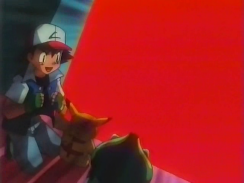 |
Altogether it was estimated that about 3.45 million children between the ages of four and twelve were watching Pocket Monsters that night. Video research at the time estimated the TV ratings during this episode were 16.5% for the Kanto region (as in the real-world Kanto located in Japan, not the Pokémon location) and 10.4% in the Kansai region.
After the scene aired, children all over Japan reported dizziness, headaches, nasuea, lost memory, and nosebleeds. The number of children affected varies from news outlet to news outlet but TV-Tokyo estimates that about 135 of the 750 total people affected had to stay in the hospital overnight.
 |
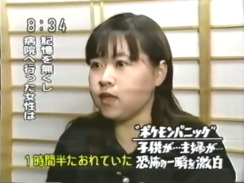 |
| Eyewitness
reports from a December 18th, 1997
broadcast of Good Morning! Nice Day. The
eight year old boy on the left says he felt his head throbbing and his
mother reported that he became unresponsive. The 23 year old woman on
the right says she passed out for about an hour and a half after
catching a glimpse of the scene in question. |
|
Benjamin Radford of the Center for Inquiry wrote this fantastic article about the incident that goes into much more detail about each of the victims and a breakdown as to what exactly caused all those people to feel ill.
The incident was given numerous names by the Japanese media, including "Pokémon Shock," "Pokémon Panic," "The Pokémon Incident," "Porygon Shock," and "Pokémon Flash."
Effects on Pokémon - Pokémon's vanishing act and the four month hiatus
After reports that children had gotten sick began to circulate, a tremendous fallout began.
TV-Tokyo, the network that airs Pocket Monsters, apologized the following day and abruptly pulled the show from its schedule. While they launched an internal investigation to find out why this happened, the network put a show called Gakkyuu Ou Yamazaki (学級王ヤマザキ) in Pocket Monsters' old time slot.
During the episode of Revolutionary Girl Utena that aired on TV-Tokyo the following night, text appeared on-screen urging viewers not to re-watch any VHS recordings they may have made of the Pocket Monsters episode the night before (きのう放送分の「ポケットモンスター」を (記録した) ビデオでご覧にならないようにお願いします). Episodes of Pocket Monsters that had already been released on home video at the time were pulled from video rental stores across the country.
The Japanese Wikipedia page for the Pokémon Shock incident states that radio show that voice actress Inuyama Inuko had at the time, "Inuko Inuyama 's Pokémon Hour" (犬山犬子のポケモンアワー), addressed the incident shortly after the episode aired. According to the article, a listener called in to Ms. Inuyama and asked two questions; are they ever going to air an edited version of the Porygon episode, and are they ever going to get around to airing "Rougela's Christmas," the episode that had been scheduled to air the following week. In regards to the Porygon episode, Inuko Inuyama said that they would like them to treat the episode as an "illusion" and as "an episode that never existed" (「あの回(第38話)は幻にしてほし い」「なかった話とし てほしい) but that they definitely do want to air the Rougela episode (あと次回分で予告された『ルージュラのクリスマス』の放送 は必ずやるので安心してほしい」). "Rougela's Christmas" did eventually air as an "extra episode" the following October.
 The
episode has never been re-aired, and, as far as all the official
companies are concerned, the episode doesn't exist. The episode's title is missing
from all official listings
of the series. In fact, the desire to expunge this episode from
existence
even went as far as to omit it from the Pocket Monsters
Film Comic, the books that take screenshots from the episodes and
arranges them into a comic book retelling of the episode.
The
episode has never been re-aired, and, as far as all the official
companies are concerned, the episode doesn't exist. The episode's title is missing
from all official listings
of the series. In fact, the desire to expunge this episode from
existence
even went as far as to omit it from the Pocket Monsters
Film Comic, the books that take screenshots from the episodes and
arranges them into a comic book retelling of the episode.A number of Pokémon-themed specials scheduled for the end of 1997 and the beginning of 1998 were also canceled as a part of the network's Pokémon blackout. TV-Tokyo's variety show "News! The Decisive Source "A Pokémon Course for Fathers"" (情報! ソースが決め手 "お父さんのためのポ ケモン講座 ") was swapped out with a highlights-of-the-year special. The December 30th episode of the network's video game variety show "64 Mario Stadium" (64マリオスタジアム) was postponed until January 18th because it featured a "Pokémon Corner" segment. Reruns of Episodes 025 and 026 of the Moomin TV series aired on the originally scheduled date instead. The "New Year's Eve Pocket Monsters Encore" (大晦日だよポケットモンスターア ンコール) special was canceled and replaced with a rerun of Mojackou (モジャ公). A mini-special named "Pokémon Quiz" (ポケモンクイズ) was replaced with "Special Program - Gift Recommendations for the New Year" (お 年玉付き新春オススメとくばん).
Meanwhile, a different TV network NHK apologized for not investigating an incident that occurred in March of that same year when an episode of YAT Relieved! Space Vacations (YAT 安心!宇宙旅行) caused similar symptoms in four children. The network didn't launch an investigation at the time because of the small number of victims. Many feel that if this incident had been investigated properly then the "Pokémon Shock" could have been avoided.
After months of fans expressing their desire for the show to return to the air, TV-Tokyo made an announcement on March 30th that the show would be coming back. When it returned it did so with two back-to-back episodes on April 16th, 1998, and was moved from 6:30pm Tuesdays to 7:00pm Thursdays. Overall, the show's hiatus lasted four months.
Effects on Pokémon - Bye Bye Porygon
In addition to all this, Porygon itself has become sort of the black sheep of the Pokémon universe. Ever since its debut episode, the Pokémon and its evolutions (Porygon 2 and Porygon Z) have never gotten a starring role in an episode. They're still in the games and the comics and all that, but outside of a few cameos in some of the movies' "World of Pokémon" segments, the Porygon line simply doesn't exist in the TV series.
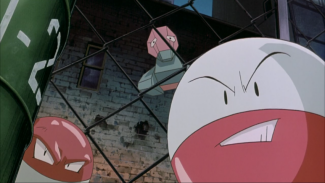 |
Many people are understandably upset by this. After all, it was Pikachu who launched the seizure-inducing attack, not Porygon. Why isn't that electric rat banned instead?
The thing is, Porygon will always be tied to this episode because of our tendency to label episodes based on the Pokémon who stars in them. If I say that I want to talk about the Garura episode, for example, you know exactly what episode I'm talking about. If I say "the Ponyta episode," you know that I mean "The Big Blazing Pokémon Race!" Episodes tend to get labeled depending on the star, and in this case, Porygon was the main attraction. Not Pikachu.
It doesn't seem like this ban on Porygon is going to be lifted anytime soon.
Effects on Pokémon - The editing of existing episodes and the creation of future episodes
After the incident, OLM and TV-Tokyo went back to all the episodes they had made up to that point and re-edited them to fit with the new guidelines that had been put in place by the National Association of Broadcasters in Japan. Scenes with a lot of flashing or quick cuts were darkened and slowed down even though those very same scenes had already aired (some of them multiple times) without incident.
Another change made was to the show's opening theme, Mezase Pokémon Master. In the pre-Pokémon Shock days, each instance of the word "naka" at the beginning of the song were accompanied by a full-screen image of a random Pokémon. For all broadcasts after the incident, those full-screen images were shrunk down to a fourth of their size and placed four to a screen. This way, only a small portion of the screen would flash when the image changed rather than the entire thing.
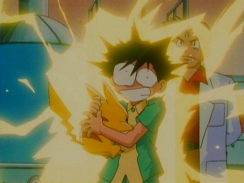 |
 |
| Certain scenes were dimmed down, slowed
down, or a combination of both in order to conform to the guidelines
set up after the Pokémon Shock incident. |
|
Episodes that were still in production when the Pokémon Shock incident occurred had to be edited similarly. Before the first movie was released in theaters, a message in the film's trailer assured parents that the movie didn't contain any flashing scenes.
 |
| The text at the bottom of the screen reads
"Pocket Monsters The Movie refrains from using extreme scenes" (劇場版「ポケットモンスター」は過激な映像表
現を抑えて制作します). Click on the image to view a
larger version. |
Episodes made after the incident were created with these new guidelines in place and therefore did not require any additional editing.
Effects
on the animation industry
The Pokémon Shock incident had effects that rippled throughout
the
entire Japanese animation industry. These effects are still being
felt today.
Reruns of older cartoons were edited in ways similar to how older Pocket Monsters episodes were edited. Reruns of shows like Revolutionary Girl Utena, Crayon Shin-chan, Rurouni Kenshin, Dragon Ball, Doraemon, and Flame of Recca have all had certain episodes re-edited to slow down and dim scenes that no longer conform to modern day guidelines.
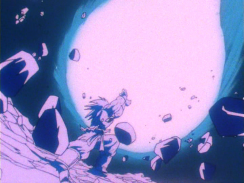 |
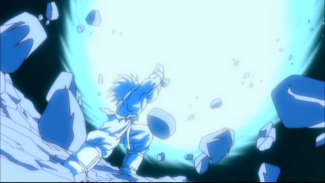 |
| In order to
conform to modern-day regulations, Toei had to reanimate Goku' s and
Vegeta's beam struggle for Dragon
Ball Kai. On the left is the scene as seen in Dragon Ball Z,
while the version on
the right is the reanimated Dragon
Ball Kai version. It's hard to tell from the still
screenshots, but the Dragon Ball Z
version flashes with a strobe light-like effect while the Dragon Ball
Kai version does not. |
|
Foreign programming must adhere to the guidelines as well. The 2003 TMNT series had frames removed and / or slowed down in order to be able to air on Japanese TV. Light saber battles in Star Wars movies get slowed down and dimmed whenever they air on TV. Footage of press conferences get slowed down due to the constant flashing of the reporters' cameras.
Like their domestic counterparts, these scenes are usually shown unedited in the home video release.
But why was all this necessary?
All of these cancellations and apologies and retroactive edits may seem ridiculous from a Western point of view, but the handling of the incident is standard protocol for these types of things in Japan. Just look around the Japanese media for a bit. L'Arc en Ciel drummer Sakura was arrested for heroin possession, so the Rurouni Kenshin ending theme his band had performed, The Fourth Avenue Cafe, was hastily swapped out with Heart of Sword. Keiichi Yamamoto, one half of the comedy duo Gokuraku Tonbo, was arrested for allegedly assaulting a minor and so scenes featuring him in a drama called "Tokyo Tower" were reshot in order to erase him from the program. In February 2009, Happy End guitarist Shigeru Suzuki was arrested for possession of marijuana and was dropped from his record label of forty years. And so on and so on.
You can argue that what happened with the Pokémon Shock incident wasn't as bad as a lot of the things I just listed. Making kids feel a little woozy isn't anywhere near the same level as, say, the Rurouni Kenshin guy owning child porn. And it's not like anybody died because of the Pokémon Shock incident so what's the big deal?
But the fact that the victims were young children is what's making all the difference here. It seems like the overwhelming majority of the people affected were elementary school kids, with only a few of the people who felt sick being any older than that. And you all know as well as I do that people have much larger reactions when minors are involved. It's just the way we are.
Is this whole thing an over-reaction? Maybe. But at the same time, none of us had to go into work the morning of December 17th, 1997 to deal with the major backlash from a nation filled with furious parents.
Is a home release likely?
Of course it isn't.
For starters, what would TV-Tokyo or OLM or Shogakukan or anyone else gain from re-opening these old wounds? Why would any sane person subject themselves to essentially telling the parents who watched their children go into shock that it's been long enough, time to move the fuck on? Just to let people watch an episode that, and let's be honest here, everyone's already bootlegged anyway? And if the episode ever got a home release in Japan then it's not like it would ever get dubbed anyway since TPCi doesn't tend to go back and dub older things. There is literally no point to a release at this stage.
Final Thought
The 38th episode of Pocket Monsters is one that will live on forever. It's a piece of animation history, and we all have a chance to witness it. Like the Miniryuu episode before it, finding bootlegged versions of this episode is extraordinarily easy and while I am very much a "support the official release" kind of guy I absolutely recommend you look this episode up if you haven't already.
| Previous Episode |
This page was last updated on October 27th, 2023
Found an error or omission? Please help me keep this page current and error-free by e-mailing me with a description of the issue.



